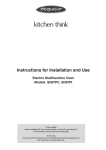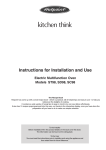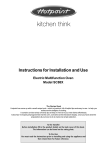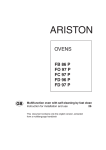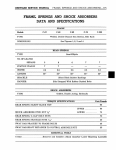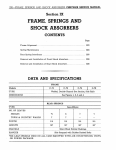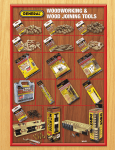Download Merloni FC 98 P.1 Owner`s manual
Transcript
FO 98 P.1 FC 98 P.1 FD 98 P.1 GB Multifunction oven with self-cleaning by fast clean Instruction for installation and use 26 Congratulations on choosing an Ariston appliance, which you will find is dependable and easy to use. We recommend that you read the instructions in this owner's manual carefully before use for the best performance and to extend the life of your appliance, as it will provide you with all the instructions you require to ensure its safe installation, use and maintenance. Always keep this owner's manual close to hand since you may need to refer to it in the future. Thank you. Close-up view C 250 200 150 A 100 40 PI ZZA H B D 12 6 13 C G 9 10 F C 250 200 150 14 100 40 PI ZZA 8 7 1 A. B. C. D. F. G. H. Control Panel Cooking mode selection knob Cooking temperature / time selection knob Electronic programmer Dripping Pan or Baking Sheet Oven Rack Guides for sliding the racks or dripping pan in and out 2 5 11 3 4 1. 2. 3. 4. End cooking time setting/ clock/ date Control panel lock / timer / cooking time setting Language setting Start cooking / stop cooking / oven light / display brightness 5. Mode description 6. Mode number 7. Cooking time 8. End cooking time 9. Graduated temperature scale 10.Energy level for grill modes 11.Time or temperature / Energy percentage 12.Electric elements in use 13.Clock display 14.Programmed cooking indicator 27 GB How to use your oven The 7 Cuochi oven combines the advantages of traditional convection ovens with those of the more modern fan assisted models in a single appliance. It is an extremely versatile appliance that allows you to choose easily and safely between different cooking modes. The various features offered by the oven are selected by means of selector knob "B" situated on the control panel. The oven light At any time, including during pre-heating and cooking, you can turn the oven light on or off by pressing button 4. When the oven is turned off, the light turns off automatically 10 minutes after the last instructions were entered onto the control panel. Cooling ventilation In order to reduce the external temperature of the oven, this appliance has been equipped with a cooling fan. During cooking, the fan is always on and a normal flow of air can be heard exiting between the oven door and the control panel. In order to raise the temperature inside the oven more quickly during pre-heating, the speed of the air outlet is approximately half the speed of air outlet during cooking. If there is a hob above the oven, the cooling fan may switch itself on automatically to protect the electronic components, even if the appliance has been switched off. Note: When cooking is done, the fan stays on until the oven cools down sufficiently. Setting the clock The clock can only be set if the oven is turned off. After the appliance has been connected to the power supply, or following a power failure, the clock displays a flashing 12:00 or the last time memorised. Any adjustments to the time setting can be made by pressing button 1 and resetting the clock using knob "C", which you can modify until the scrolling writing disappears completely from the display. Setting the date To update the date, press button 1 until the word "YEAR" comes up on the display. Update the year by turning knob "C" and then press button 1 to set the month, again using knob "C". Press button 1 again to set the day using knob "C". Press button 1 to memorise the date set. How To Use Your Oven Turn knob "B" clockwise to choose from the default cooking modes or among the pre-entered recipes available (see Ariston recipe book). For each cooking mode, the display will indicate the following: • the cooking mode name (or that of the recipe); • the cooking mode number (or that of the recipe); • the default temperature; • the heat sources; Should the recommended temperature not be to your liking, you can always adjust it using knob "C". Each cooking mode is also associated with a recommended cooking time, which you can modify, from one minute to 10 hours, by pressing button 2 and then turning knob "C" to set it to the desired value. The cooking time can be adjusted until the scrolling wording disappears completely from the display panel. The selected cooking time does not include the time required for preheating the oven. To start cooking, press cooking start button 4. Timer Feature The timer can only operate when the oven is turned off. Please remember that the timer does not control the starting or stopping of the oven, it merely sounds a buzzer when the time is up and can be interrupted at any time just by pressing a button. To set the timer, press button 2, and then make the necessary adjustment using knob "C". Press button 4 to start the timer. At all times during the timer operation, you may: • adjust its duration using knob "C"; • stop the countdown by pressing button 4 for approximately 3 seconds or turning knob "B" anticlockwise; • enable/disable the control panel lock, by pressing button 2 for at least 3 seconds (see the paragraph entitled "Locking and Unlocking the Control Panel"). Selecting the language Press button 3 for a few seconds with the oven turned off. The languages available appear in sequence on the display panel. Press button 3 again to select the desired language. With the exception of the "Fast cooking" and "Grill" modes, the oven will now begin the pre-heating stage, during which you may still: • change the temperature by turning knob "C"; • change the cooking time by pressing button 2 and then turning knob "C"; • enable/disable the control panel lock, by pressing button 2 for at least 3 seconds (see the paragraph entitled "Locking and Unlocking the Control Panel"); • stop cooking and turn the oven off by turning knob "B" anti-clockwise. Note: pre-heating is performed automatically by the appliance, which sets the pre-heating time according to the temperature selected by the user. The display panel will feature how long the oven will take to preheat before cooking starts. Selecting the display panel brightness To update the date, press button 4 until the word "BRIGHTNESS" comes up on the display. Turn knob "C" clockwise/anticlockwise to increase/ decrease the brightness of the display panel. A few seconds after this selection, the oven will be ready for further instructions. Locking and Unlocking the Control Panel This option enables the user to lock all the buttons and knobs. We especially advise you to use this option if there are children present. To enable the control panel lock, press button 2 for a few seconds. The word "LOCKED" comes up on the display. To restore the usual commands to the appliance, just press button 2 again for a few seconds. The word "UNLOCKED" will come up on the display. GB Once the temperature set has been reached, the oven starts the cooking stage in itself, during which you may 28 still: • change the temperature by turning knob "C"; if you increase it by more than 25°C, the oven returns to the pre-heating mode; • change the cooking time by pressing button 2 and then turning knob "C"; • enable/disable the control panel lock, by pressing button 2 for at least 3 seconds (see the paragraph entitled "Locking and Unlocking the Control Panel"); • stop cooking and turn the oven off by turning knob "B" anti-clockwise. Once cooking is done, the wording "END-READY" will come up on the display, and a buzzer will sound, which will stop after 1 minute, after you press a button or after you turn one of the two knobs. The air heats up upon contact with these heat sources, and circulates around the inside of the oven to provide uniform heat, as the hot, lighter air tends to rise. This is caused by natural convection. This cooking mode is especially recommended when cooking simmered recipes using covered casserole dishes (hotpots, tripe, etc.) or for Bain Marie cooking (crème caramel, terrines, etc.). In this case, use the dripping pan as a dish support and place it on the 2nd rack from the oven bottom. We recommend you pre-heat the oven before placing your dishes in it. : "Pastry" Only the circular heating element and the fan come on to provide delicate heat, suitable for baking cakes and pastries such as brioches, chocolate cake, fruitcake, sponge cake, mini cup cakes, meringues, etc. In this case, use the dripping pan as a dish support and place it on the 2nd rack from the oven bottom. We recommend you pre-heat the oven before placing your dishes in it. Notice: The first time you use your appliance, we recommend that you set the thermostat to the highest setting and leave the oven on for about half an hour with nothing in it. Then, open the oven door and let the room air. The odour that is often detected during this initial use is due to the evaporation of substances used to protect the oven during storage and until it is installed. : "Fast cooking" The combination of all the heating elements together with the fan guarantees a uniform distribution of heat throughout the oven. This particular cooking mode is ideal for fast cooking (not requiring any pre-heating) and for cooked dishes (frozen, pre-cooked food). In this case, use the dripping pan as a dish support and place it on the 2nd rack from the oven bottom. Notice: Place the dripping pan provided on the bottom shelf of the oven to prevent any sauce and/or grease from dripping onto the bottom of the oven only when grilling food or when using the rotisserie (only available on certain models). For all other types of cooking, never use the bottom shelf and never place anything on the bottom of the oven when it is in operation because this could damage the enamel. Always place your cookware (dishes, aluminium foil, etc. etc.) on the grid provided with the appliance inserted especially along the oven guides. : "Multicooking" The combination of all the heating elements together with the fan guarantees a uniform distribution of heat throughout the oven. This cooking mode is recommended for cooking several dishes on more than one rack. Even if the dishes vary in nature, their respective flavours are maintained during cooking. When using this cooking mode, all the dishes should require the same cooking temperature (you just need to take them out gradually as each one is ready). When cooking on two racks, for example, use the dripping pan as a dish support on the first oven rack from the bottom and the grid on the third rack from the bottom. We recommend you pre-heat the oven before placing your dishes in it. : "Pizza" The heating elements (bottom and circular) are turned on to heat the oven up quickly. Your pizzas and tarts will benefit from a greater amount of heat from below, thus guaranteeing the rapid baking of the dough during cooking. As for the fan, the latter browns the surface as necessary, making the food even more appetising. Use the dripping pan as a dish support and place it on the 1st rack from the oven bottom. We recommend you pre-heat the oven before placing your dishes in it. Notice: the appliance is fitted with a diagnosis system which detects any malfunctions. The user is informed of the latter by messages such as: • "F nn" (nn = a number comprising two digits): in these cases, you need to call for technical assistance as the oven is faulty; • "W nn" (nn = number comprising two digits): in these cases, it is best to call for technical assistance as the oven has detected a malfunction, although it continues to operate. Cooking mode description The cooking modes are selected by turning knob "B". ance. Excellent results can be attained when cooking vegetable-based side dishes like courgettes, aubergines, peppers, etc. Desserts: this mode is also perfect for baking leavened cakes. The "Multi-cooking" mode can also be used to thaw red or white meat and bread, by setting the temperature to 80 °C. To thaw more delicate foods, set the thermostat to 60°C. : "Traditional" This is the oldest cooking mode suitable for cooking individual dishes. Two heating elements (one at the top of the oven and the other at the bottom) work together. : "Grill" The top heating element comes on: the grill goes red and emits infrared rays just like those contained in sunlight. 29 GB liquid content, such as shortbread biscuits, jam tarts and savoury biscuits (shortcrust pastry). We recommend the use of the second oven rack from the bottom. Preheat the oven first. In fact, this cooking mode does not essentially intend to heat up the air inside the oven, but rather to expose the food directly to these rays. Use this cooking mode with the oven door closed. We recommend you start with the oven cold. The amount of heat radiated is adjustable on the temperature selector. Place the dripping pan on the first rack from the bottom in order to catch any fat or juices that may drip from the dish and place the grid on one of the top racks depending on the size of the meat. Your appliance is fitted with a rotisserie, which can be used with the "grill" and "gratin" modes. Always keep the oven door shut when using the rotisserie and start with the oven cold in order to avoid scalding yourselves when positioning the spit. Place the dripping pan on the 1st oven rack from the bottom to catch any dripping fat or juices and position the rotisserie on the 3rd rack from the oven bottom (please see the next paragraph for instructions on positioning the rotisserie). : "Gratin" Only the top heating element comes on, with the emission of infrared rays. The forced circulation of air caused by the fan at the back of the oven ensures the uniform distribution of heat throughout the latter, and all foods thus benefit from the following at the same time: • the infrared rays that guarantee the perfect cooking of the food surface, thus sealing in the tenderness and juices in the case of meat, • the hot air that also allows for the food to be cooked thoroughly via conduction. This cooking mode is recommended when cooking roasts (red or white meats), and for poultry. Place the grid on the 2nd rack from the oven bottom as a support for the meat and the dripping pan on the 1st rack from the bottom to catch any dripping fat or juices. Always place your food in the oven when it is cold. When using the "grill" or "gratin" modes, remember to keep children away from the accessible parts of the appliance as they become very hot. : fast clean This process cleans the oven fully. For further details on the oven's fast clean properties, please see page 33. : Ventilated oven The circular heating element and the fan come on, providing “delicate” heat which is ideal for baking recipes with a low Programming the cooking mode To programme the cooking mode, follow the instructions below: • select the cooking mode by turning knob "B", and the temperature by turning knob "C". • set the cooking time by pressing button 2. The recommended cooking time comes up on the display, and you can adjust the same by turning knob "C". Please remember that the time entered does not include the necessary pre-heating stage. • set the end cooking time by pressing button 1. The display panel will feature the end cooking time obtained by adding the current time to the previously selected cooking time, as well as the time necessary for the oven to preheat (automatically calculated by the appliance according to the cooking mode selected). Turn knob "C" until the display panel features the time you want the food to be ready. GB • After these selection procedures, the display panel will feature the time at which preheating will commence (where foreseen), and that at which cooking will be over. The latter can be altered up until the cooking mode and temperature reappear on the display panel. Any incorrect data can be corrected simply by repeating the above-stated instructions. press button 4 to activate the programming. To modify the settings made, press button 4 for approximately 3 seconds and repeat the above procedures. To cancel a programmed cooking To cancel a cooking schedule already programmed.To cancel any programme which has been entered, turn knob "B" anticlockwise until the word "OFF" appears on the display panel. 30 How to Keep Your Oven in Shape Inside the oven We recommend you clean your oven each time you use it, especially after cooking roasts. In fact, it is advisable to prevent food residue from building up during cooking: the residue would be re-cooked each time the oven is used and would char and release smoke and unpleasant odours. FC 98 P 1 Oven exterior Clean the enamelled or stainless steel exterior surfaces of your oven using a sponge soaked in soapy water, making sure you rinse and dry these thoroughly, without using abrasive or corrosive products which could damage them. 2 3 Replacing the oven lamp • Always unplug the appliance from the mains or switch off the main switch before all operations. • With the aid of a narrow, flat item (such as a screwdriver or a spoon handle, etc…), remove the glass cover. • Unscrew the lamp and replace it with another featuring the same characteristics: - voltage 230/240 W - wattage 15 W - type E 14 Stainless steel Rinse stainless steel parts and dry them thoroughly using a soft cloth. Use a specific non-abrasive product to remove tougher stains, Using aluminium foil To avoid having to clean the bottom of the oven, you may be tempted to line the same with some aluminium foil. We strongly advise against this. The aluminium foil sheet in direct contact with the heated enamel coating could melt and damage the enamel coating inside the oven irreversibly. • Replace the glass cover and ensure you reposition the seal correctly. Cleaning the rotisserie and other accessories The rotisserie can be removed completely thanks to the 2 wing nuts. The elements comprising the rotisserie assembly should be cleaned together with the other accessories (dripping pan, grid) in the sink using a damp sponge and ordinary detergent or even in your dishwasher. Oven compartment Disassembling the oven door The oven door can easily be removed to clean the space between the bottom of the door and the front of the oven. To disassemble the door, proceed as follows: • open the oven door fully, • lift up and turn the small levers situated on the two hinges, • shut the door, but not completely, • grip the door on the two external sides and pull it towards you, pulling it out of its seat. Reassemble the door by following the above procedures backwards. Lamp Seal Glass door FO / FD 98 P 1 2 3 31 GB Fast clean Safety devices How to start the cleaning process In fast clean mode, the temperature inside the oven reaches 500°, which is necessary for the destruction of food and fat residue, as illustrated below. • Shut the oven door. • Turn knob B and set it to FAST CLEAN • The cleaning process takes approximately 90 minutes. Given this high temperature, your oven is fitted with some safety devices: • the oven door is locked automatically as soon as the temperature is high in order to avoid all risks of burns. • the heating elements are no longer powered if an anomaly occurs. You can set the duration of the cleaning cycle (60 - 90 - 120 minutes) depending on the degree of soil of your oven. • Press key 4 to start the cycle. Just as for cooking, you can set a fast clean cycle with a delayed start. ð The oven door is locked automatically as soon as you start a fast clean cycle. ð The key indicator light flashes while the door is being locked and the cycle time gradually decreases. The indicator light stops flashing and stays on as soon as the oven door is locked. Note: When looking through the oven door, you may notice some particles that light up when they are destroyed by pyrolysis upon contact with the heating elements: this is simply spontaneous combustion, it is extremely normal and without danger. As long as the temperature inside the oven stays below 125°C, you can unlock the oven door by pressing key 3 for 3 seconds. The door is unlocked immediately. If you forget to relock the oven door again, the latter will be locked automatically as soon as the temperature inside the oven reaches 325°C. Precautions to be taken before performing the fast clean process 1- Try to remove the larger food residue from inside the oven using a wet sponge. We highly advise against the use of detergents or all other products recommended for cleaning ovens. 2- Remove all the accessories from the oven: they are not designed to withstand such high temperatures. What's more, some of these accessories would alter the result of the pyrolytic self-cleaning process and obstruct the circulation of heat inside the oven. The accessories can easily be cleaned like everyday crockery and are dishwasher-proof. 3- Don't leave any tea towels on the oven door handle. What happens at the end of the fast clean cycle? • The programmer beeps, • and the word END comes up on the display. Press key 4 to stop the beeping, the word END disappears and the key indicator light flashes. You may only open the oven door after the temperature inside the oven has dropped sufficiently. You will notice some white dust deposits on the bottom and sides of the oven, remove them with a damp sponge when the oven has cooled down completely. If on the other hand you want to take advantage of the heat accumulated during the process to start cooking, the dust can stay where it is: it is completely harmless and will not affect your food. Warning: the oven surfaces may get hot during the fast clean process: keep children well away. Troubleshooting DO NOT WORRY IF… Some operating anomalies may arise. These are generally due to incorrect handling or to the erroneous valuation of a phenomenon. If your oven releases a lot of smoke during cooking: • Make sure you have selected the correct cooking mode for the type of dish you want to prepare and that you have selected the right accessories and put the dish in the oven at the recommended rack height. • Check the temperature selected: it is no doubt too high for the type of cooking required. • Check the degree of soil of the oven, and whether the latter needs to be cleaned. Food residue encrusted onto the enamel coating inside the oven becomes charred and creates both smoke and pungent smells. • Splashes of grease or overflows onto very hot surfaces could crate smoke. GB 32 The accessories Your oven offers you many differing cooking modes. These can only be achieved thanks to a certain number of accessories which we have chosen for you. These accessories slide in and out of the different oven racks inside your oven and can thus be positioned in accordance with the individual cooking requirements of differing foods and dishes. The rotisserie Wing screw Spit cradle Spit Prong Rung n˚ 5 Rung n˚ 4 Spit handle This specific accessory is ideal for roasting meats, as the latter rotate slowly and are browned uniformly until cooking is done. It is comprised of the following: • a support situated on the 3rd oven rack from the oven bottom so the rotisserie fits into the hollow shaft of the rotisserie motor located at the back of the oven, behind the perforated oven back panel. • a spit that passes through the roast, which is kept firmly in place on both ends by two adjustable sliding forks each fastened onto the spit by means of a wing nut. Warning: when positioning the rotisserie assembly, ensure the spit fits firmly into the hollow shaft connected to the motor. Make sure you position the following correctly: - the spit in the centre of the roast - the roast at an equal distance from both ends of the spit. • a removable handle made of insulating material to screw onto the front of the spit allows you: - to have a rotisserie which is long enough for even the largest of roasts - to avoid scalding yourself when removing the roast at the end of cooking. Screw on the handle tightly to take out the spit (the handle should be removed from the spit during cooking). Rung n˚ 3 Rung n˚ 2 Rung n˚ 1 Trammels The dripping pan Use it: • as a dish support for all dishes when cooking on one rack only and in Bain Marie cooking, • as a support for food (mini cup cakes, etc.), • as a dripping pan to catch juices and fat dripping from food situated on the large grid. We advise against using the dripping pan on the 4th and 5th racks from the oven bottom. The large grid Always use the large grid with the edges upwards and together with the dripping pan. • When it is positioned on the 2nd rack from the oven bottom, it acts as a meat support, with the dripping pan placed on the 1st rack from the bottom to catch any dripping fat or juices. • When it is positioned on the top rack (depending on the size of the foodstuff) for grilled food, the dripping pan is to be placed on the 1st rack from the oven bottom to catch any dripping fat or juices. • When it is positioned on the top rack for cooking on more than one rack. Rotisserie timer ARISTON ovens are fitted with a rotisserie timing device. When cooking is done, the rotisserie motor continues to turn the spit and only comes to a stop when the temperature inside the oven has dropped sufficiently: this prevents the surface of the meat from burning. When cooking is done, leave the mode selector set to the cooking mode under way and set the temperature selector back to the minimum setting. We advise against placing meat directly onto the dripping pan when using the "gratin" mode as the fat and juices heated from below in this particular cooking mode could in fact char and splash onto the oven inside panels and create smoke. 33 GB A FEW EXAMPLES OF COOKING ON ONE LEVEL Dish Cooking mode Temperature Time Shelf level Remarks Preheat Bread (1 kg loaf) Multicooking 210°C 30-35' 2 on backing tray Yes Savoury pasties Multicooking 200°C 20-25' Depending on thickness 2 on backing tray Yes Pizza (bread dough) Pizza 240°C 10-15' 1 on backing tray Yes Quiche Pizza 220°C 30' 1 Tin on backing tray Yes Cheese soufflé Multicooking 200°C 30-40' 2 Tin diam. 20 cm on backing tray Yes Pâté Traditional 180°C 50-60' 2 Bain-marie on backing tray (start with hot water) Yes Leg of lamb Gratin 210°C 1 hour for 1,5 à 2 kg 2-1* Meat on shelf No Potatoes au gratin cooked with cream Gratin 200°C 40-45' Depending on thickness 2 Tin on backing tray Yes Fish Traditional Gratin Grill 200°C 240°C 250°C Depending on type and thickness of fish 2 2-1* 2-1* Fillets + liquid, enamelled tray Whole on shelf Fish on shelf for grilling Yes Chicken Gratin Rotisserie grill 210°C 250°C 1 hour for 1,2 à 1,5 kg 2-1* 3-1* Meat on shelf Rotisserie,oven door shut No Roast beef Gratin 210°C Depends on how well cooked required 2-1* Meat on shelf No Roast pork Gratin 210°C 1 hour for 1kg 2-1* Meat on shelf No Roast veal Gratin 210°C 1 hour for 1kg 2-1* Meat on shelf No Stuffed tomatoes Multicooking 200°C 20-25' 2 Tin on backing tray Yes Frozen meals Fast cooking Follow instructions on packet Follow instructions on packet 2 Tin on backing tray No Lasagne Fast cooking 200°C Depending on thickness 2 Tin on backing tray No Moussaka Fast cooking 200°C Depending on thickness 2 Tin on backing tray No Buns Pastry 160°C 35-45' 2 Aluminium tin on backing tray Yes Cake Pastry 160°C 60' 2 Aluminium tin on backing tray Yes Profiteroles Pastry 200°C 20-25' 2 Small savoury profiteroles on backing tray Yes Crème caramel Traditional 180°C 30' 2 Individual ramekins in bainmarie (start with hot water) Yes Sponge cake Pastry 190°C 30' 2 Aluminium tin on backing tray Yes Macaroons Pastry 180°C 15-20' Depending on thickness 2 on backing tray Yes White meringues Pastry 70-80°C 3 hour Depending on thickness 2 Drying small meringues Yes Blond meringues Pastry 110°C 2 hour Depending on thickness 2 Drying small meringues Yes Baked apples Multicooking 210°C 20-25' Depending on thickness 2 Tin on backing tray Yes Shortbread biscuits Pastry 190°C 10-15' 2 on backing tray Yes Apple tart Pizza 220°C 30' 1 Cake tin on backing tray Yes Shortbread biscuits Ventilated oven 190°C 10-15' 2 Aluminium baking tin on backing tray Yes Jam tart Ventilated oven 190°C 15-25' 2 Aluminium baking tin on backing tray Yes Savoury biscuits Ventilated oven 190°C 10-15' 2 Aluminium baking tin on backing tray Yes X - Y* in the "Shelf level" column X = shelf or spit rod at level X Y = baking tray at level Y to catch the roasting juices Reminder: always place the shelf with the indentations facing downwards GB 34 Safety Is A Good Habit To Get Into To maintain the efficiency and safety of this appliance, we recommend that you do the following: • only call the Service Centres authorised by the manufacturer • always use original spare parts • • • • This appliance is designed for non-professional, household use and its functions must not be changed. These instructions are only valid for the countries whose symbols appear on the manual and the serial number plate. The electrical system of this appliance can only be used safely when it is correctly connected to an efficient earthing system in compliance with current safety standards. When the appliance is in use, the heating elements and some parts of the oven door become extremely hot. Make sure you don't touch them and keep children well away. Qualified personnel must be contacted in the following cases: - Installation (following the manufacturer's instructions); - When in doubt about operating the appliance; - Replacing the electrical socket when it is not compatible with the appliance plug. Service Centres authorised by the manufacturer must be contacted in the following cases: - If in doubt about the soundness of the appliance after removing it from its packaging; - If the power supply cable has been damaged or needs to be replaced; - If the appliance breaks down or functions poorly; ask for original spare parts. The following items are potentially dangerous, and therefore appropriate measures must be taken to prevent children and the disabled from coming into contact with them: - Controls and the appliance in general; - Packaging (bags, polystyrene, nails, etc.); - The appliance itself, immediately after use of the oven or grill due to the heat generated; - The appliance itself, when no longer in use (potentially dangerous parts must be made safe). It is a good idea to do the following: - Only use the appliance to cook food and nothing else; - Check the soundness of the appliance after it has been unpacked; - Disconnect the appliance from the electrical mains if it is not functioning properly and before cleaning or performing maintenance; - When left unused, unplug the appliance form the electricity mains and turn off the gas tap (if foreseen); - Use oven gloves to place cookware in the oven or when removing it; - Always grip the oven door handle in the centre as the extremities of the same may be hot due to any hot air leaks; - Make sure the knobs are in the "•"/"o" position when the appliance is not in use. - Cut the power supply cable after disconnecting it from the mains when you decide not to use the appliance any longer. • The manufacturer may not be held responsible for any damage due to: incorrect installation, improper, incorrect and irrational use. Avoid the following: - Touching the appliance with wet parts of the body; - Using the appliance when barefoot; - Pulling on the appliance or the supply cable to unplug it from the electrical outlet; - Improper or dangerous operations; - Obstructing the ventilation or heat dissipation slots; - Allowing power supply cables of small appliances to come into contact with the hot parts of the appliance; - Exposing the appliance to atmospheric agents such as rain, or sunlight; - Using the oven for storage purposes; - Using flammable liquids near the appliance; - Using adapters, multiple sockets and/or extension leads; - Attempting to install or repair the appliance without the assistance of qualified personnel. 35 GB INSTALLATION The panels of the adjacent cabinets must be made of heatresistant material. In particular, cabinets with a veneer exterior must be assembled with glues which can withstand temperatures of up to 100 °C. In compliance with current safety standards, contact with the electrical parts of the oven must not be possible once it has been installed. All parts which ensure the safe operation of the appliance must be removable only with the aid of a tool. For the correct centring of your appliance, position the 4 tabs on the sides of the oven in correspondence with the 4 holes on the perimeter of the frame. In particular, if the cabinet side panel: • is 20 mm thick: the removable part of the tab must be removed (Fig. A); • is 18 mm thick: use the first groove, which is factoryset (Fig. B); • is 16 mm thick: use the second groove (Fig. C). The appliance must be installed only by a qualified person in compliance with the instructions provided. The manufacturer declines all responsibility for improper installation which may harm persons and animals and damage property. Important: The power supply to the appliance must be cut off before any adjustments or maintenance work is done on it. 558 mm 5 mm. . 593 mm. m. 45 m 567 mm. 595 mm. 20/23 mm. Installation of Built-in Ovens In order to ensure that the built-in appliance functions properly, the cabinet containing it must be appropriate. The figure below gives the dimensions of the cut-out for installation (N.B.: Installation in compliance with the consumption declaration) under the counter or in a wall cabinet unit. 595 . mm 545 . mm Fig. A Fig. B . 8 0/2 mm m. 45 m . min 45 . mm . n mi Fig. C To fasten the oven to the cabinet, open the door of the oven and attach it by inserting the 4 wooden screws into the 4 holes located on the perimeter of the frame. 5 mm. . 595 mm. mm 575-585 mm. 558 567 mm. 595 mm. 20/23 mm. 2 595 . mm 545 . mm . 28 20/ mm In order to ensure adequate ventilation, the back panel of the cabinet unit must be removed. Installing the oven so that it rests on two strips of wood is preferable. If the oven rests on a continuous, flat surface, there must be an aperture of at least45x560mm. GB 36 Fastening the oven to the cabinet (only on models FC...) 1. Place brackets "A" up against the oven support "B". 2. Place the tabs "C" up against brackets "A". In particular, if the cabinet side panel: • is 16 mm thick: mount the tab so that the number 16 it features is facing you; • is 18 mm thick: mount the tab so that the part without any wording is facing you; • is 20 mm thick: do not mount the tab. 3. Fasten the brackets and tabs on the oven cabinet side panel using screws "D". 4. Fasten the oven to the cabinet using the screws and plastic washers "E". D 16 C 16 A D C E 16 16 D C E B Electrical connection Important: After connecting the appliance to the flexible cable, tighten all the screws on the terminal board. Connection First check the mains electricity supply available (number of phases - voltage - maximum power necessary) to ensure these are compatible with the requirements of the Ariston appliance to be connected. Ariston ovens can adapt to the following electrical systems: Electrical connections Voltage Frequency Fuse Section This appliance conforms with the following European Community directives: DBT 73/23 EEC modified by 93/68/EEC directive CEM 89/336/EEC modified by 92/31/EEC and 93/68/EEC directives FR-AT-BE-DE-GP-ES-IE-IL-IS-IT-DK LU-RE-FI-GB-GR-PT-SE-MA-NZ-NL 230 V-1+N ~ 50 Hz N L 16 A 1,5 mm² CY-MT-AU-NZ-KW 240 V-1+N ~ 50 Hz FR-BE-NO L2 L1 230 V-2 ~ 50 Hz 16 A 1,5 mm² Inner dimensions of the oven: width depth height You can connect your oven to the system by means of a terminal board. Please refer to the table above for the minimal cable sections and the calibration of the protective elements according to the connection. If the appliance is installed with a junction box, an omnipolar circuit breaker - with a minimum contact opening of 3 mm - should be installed between the appliance and the mains. We recommend you use a power supply cable which is long enough to allow you to take the oven out of its recess in the event of maintenance operations (only use HAR H 05 - RRF quality cables fitted with a plug conforming to the regulations in force in the country where the appliance is fitted). The plug must be accessible at all times. 43.5 cm 40.0 cm 32.0 cm Inner volume of the oven: 56 litres Voltage and frequency of power supply: 230V~50Hz : 2800 W 240V~50Hz : 3050 W Energy Label Energy Label Directive 2002/40/CE of electric ovens. Norm EN 50304. Energy consumption (based on standard load) : Conventional Forced air convection Unplug the appliance before all operations, even when replacing the oven lamp. Using the appliance without correct earthing is highly dangerous. 37 GB 06/04 - 19503555202 - Xerox Business Services - Docutech Merloni Electroménager S.A. BP 80048 - 57101 Thionville Cedex tél 03.82.55.75.00 - fax 03.82.55.77.80 http://www.merloni.com













